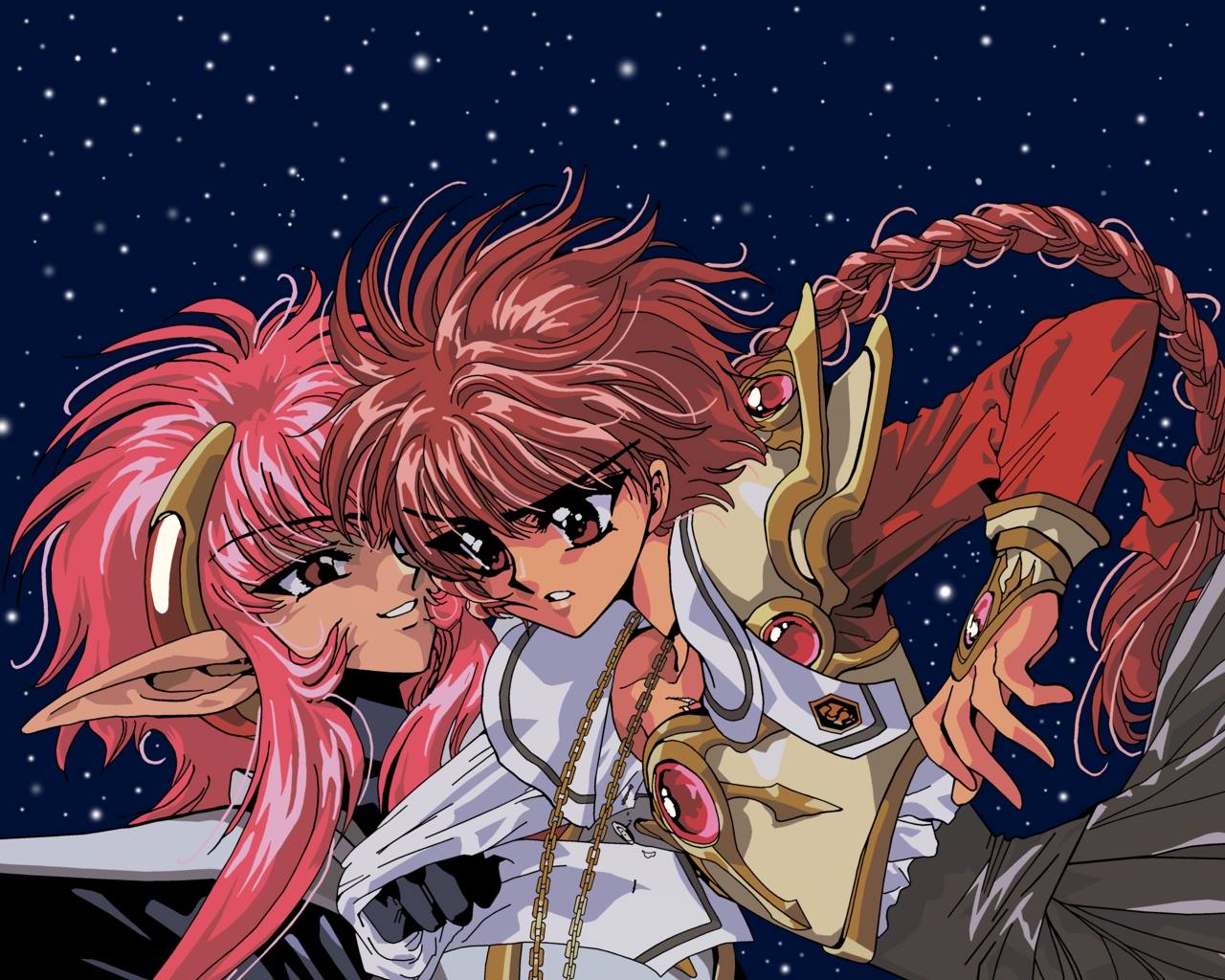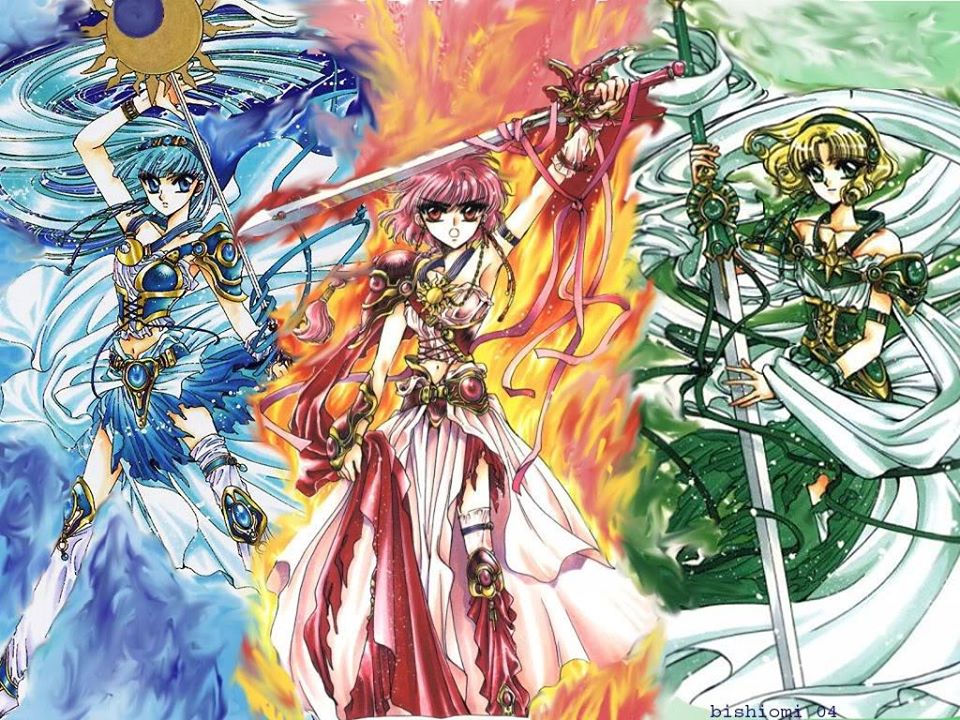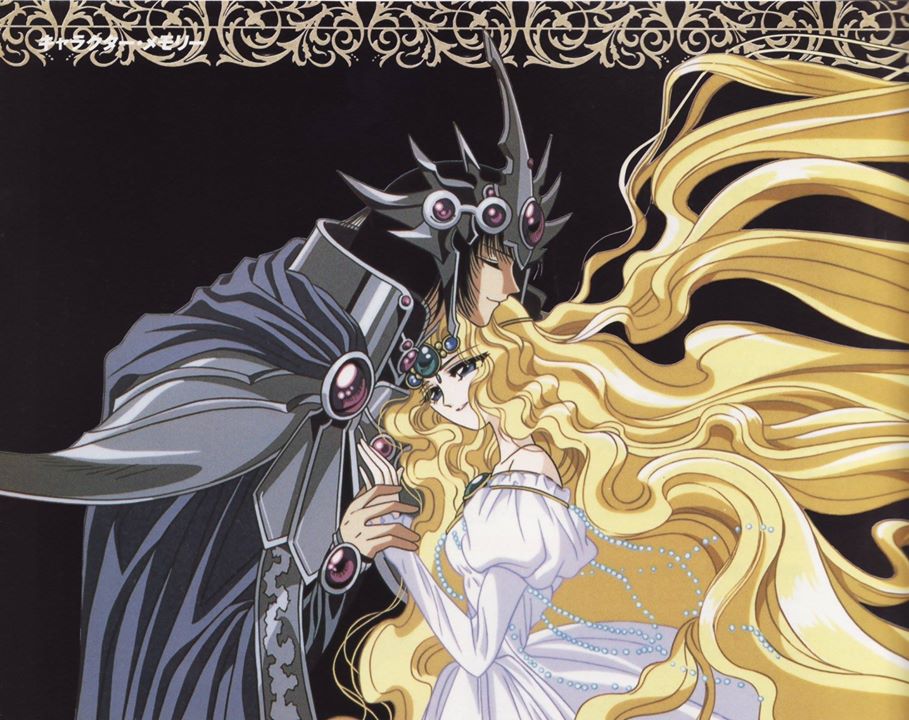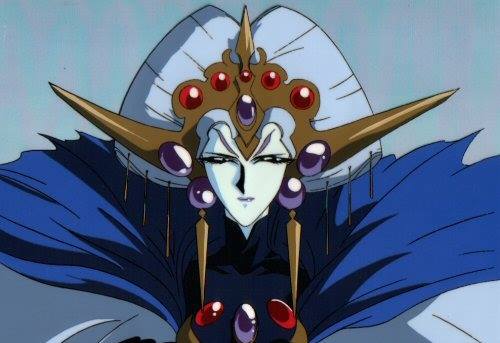Introduction
Many fantasy and science fiction stories follow the same pattern, the Hero’s Journey (or Monomyth), outlined by Joseph Campbell, in his “The Hero with a Thousand Faces”. Books, movies, and video games all seem to fall prey to this ubiquitous plot arc, and Anime is no different. One such series, Magic Knight Rayearth, does so quite exactly and even stereotypically. However, what I find particularly interesting is that the second season of it (MKR2) manages to flip the arc on its head, which is rare. In fact, it is not just different, it’s a near mirror image. While at the same time maintaining a theme of mirroring. So much so, that I wonder if it was intentional.
Note: Complete spoilers for both seasons follow. If you are interested in watching these, go ahead and take the time, they’re worth it. It’s certainly one of the best Anime series in my collection. Season one is a first class hero’s journey, and season two is a real psychological dive into despair and self-loathing, and the power of confronting and embracing one’s darkest feelings, in order to generate one’s own hope. But I digress.
 Characters from Rayearth Season 1 – Top row: Zagato, Presea, Ferrio, Lafarga, Ascot, Clef – Bottom Row: Alcyone, Caldina, Hikaru, Umi, Fuu, Emeraude
Characters from Rayearth Season 1 – Top row: Zagato, Presea, Ferrio, Lafarga, Ascot, Clef – Bottom Row: Alcyone, Caldina, Hikaru, Umi, Fuu, Emeraude
Hero’s Journey
A quick reminder of the Hero’s Journey arc, taken from WikiPedia:
- Departure
- The Call to Adventure
- Refusal of the Call
- Supernatural Aid
- Crossing the Threshold
- Belly of the Whale
- Initiation
- The Road of Trials
- The Meeting with the Goddess
- Woman as Temptress
- Atonement with the Father
- Apotheosis
- The Ultimate Boon
- Return
- Refusal of the Return
- The Magic Flight
- Rescue from Without
- The Crossing of the Return Threshold
- Master of Two Worlds
- Freedom to Live
Summary
A simple summary of the plotline of both seasons can be found on WikiPedia here, or episode by episode summaries over here – start at the bottom (“Departure and New Ties” for Season 2, or open the “Season 1” tab and find “The Birth of the Legendary Magic Knights” for Season 1) and go up. Or in my own words, as follows. Season 2 is both longer and more complex, as you see.
Season 1
Three high school girls from different schools, Hikaru, Umi, and Fuu, meet during a field trip to Tokyo Tower. A bright light flashes and the three witness a blonde woman floating outside in the air, asking for help. They all wake up in an alternate world called Cephiro, where willpower is a literal force of nature and what you envision in your head can come true. They meet a magician, Clef, who is their spiritual guide, who tells them to save the world and rescue Princess Emeraude from the dark priest Zagato. The world there is beset by monsters and an encroaching darkness, and the Princess, who is a deity-like character, is needed to pray for Cephiro to hold the monsters at bay, but cannot while she is kidnapped.
Over the course of several adventures, they learn to cast magical spells, find a magical ore from which they are forged weapons and armor that grow as they increase in bravery, and eventually awaken 3 giant god-robots (Ma-Shin) that they can pilot. Zagato and his minions try to stop them but are thwarted one by one.
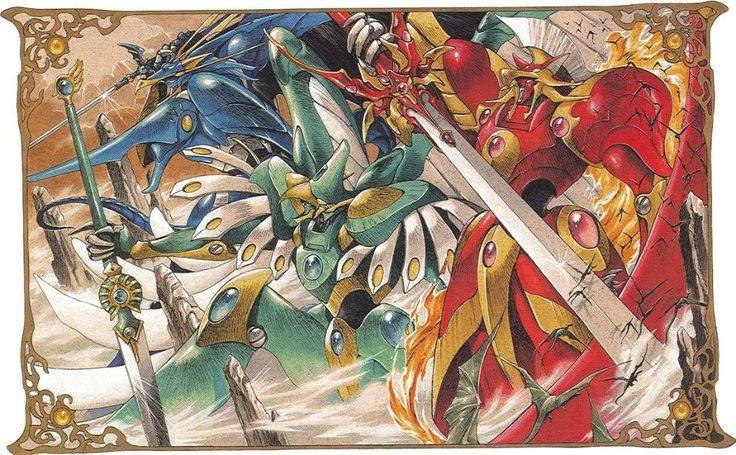 Umi, Fuu, and Hikaru in their Ma-Shin’s
Umi, Fuu, and Hikaru in their Ma-Shin’s
However, eventually, it becomes clear that things are not as they originally thought. Princess Emeraude, the “Pillar” of Cephiro, is indeed needed to pray for the world to hold the monsters at bay, but…The reason she isn’t able to pray is not because she’s kidnapped, but because she can’t focus all her energy on her prayers, due to having fallen in love long ago with Zagato, the main antagonist. It turns out that the Pillar is effectively godlike and immortal, but not free of emotional needs. But there’s no way to give up being Pillar, no escape from the responsibility. The only way to do it is for Emeraude to summon Magic Knights from another world so that they can gain enough power to murder her and put her out of her emotional anguish. Zagato didn’t kidnap her to hold her hostage, he is trying to protect her from the murderers she summoned, because he doesn’t want her to die. But the Princess loves Cephiro, too, and can’t support it properly, so if she remains in this state, she’ll only cause it’s ruin… the only way out is to get killed by the Magic Knights and hope for a new Pillar to take over.In the end, after the Magic Knights kill Zagato, the Princess emerges, consumed with grief and despair, not just for her loss of Zagato, but for the world nearly being destroyed at her own selfish hands, all just because she loved someone. So she turns into a giant, nearly all-powerful Ma-Shin herself and fights the Magic Knights to the death. The three protagonists are beset by doubt and self-hatred at having to kill the person they thought they were trying to save, but they do so, out of both self-preservation and duty. In the act of doing so, two significant, “silent” things happen that go unnoticed at the time: (1) Hikaru in particular screams in rage and terror and self-doubt as she and her friends plunge their swords into Emeraude’s Ma-Shin, destroying it and slaying Princess Emeraude, and (2) the people of Cephiro cry out in shock and horror at the loss of their Pillar and their hope against the monsters.
Emeraude and Zagato find eternity together in the afterlife, and Magic Knights return to Earth, shaken but braver for it all.However, one thing is clear: there is no Pillar, so Cephiro’s problems have not really been solved.
Season 2
A year passes, and the 3 remained friends back on Earth. They return to Tokyo Tower together to reminisce. This time, they see a dark silhouette of a woman outside, someone they don’t recognize, and they despair over the state in which they left Cephiro.They are transported back to Cephiro, but not by Emeraude (who is dead), and not by any force that Clef can discern, but rather by the person that will become Pillar, who they have not yet found. Most of their friends from season 1 are there, plus we are introduced to Zagato’s younger brother and successor of sorts, Lantis. They find that Cephiro is literally on the brink of doom. The lack of a Pillar to pray for peace has wreaked havoc on the landscape, and only the central castle and some surrounding land remain. Monsters roam the darkness, the people are all huddled in the castle in fear, and the surrounding nations outside Cephiro smell blood, seek conquest, and invade.The Magic Knights get their powers back — magic, swords, Ma-Shin and all — and go out to stop the invasions. At first they succeed at delaying them, one by one. Hikaru is also haunted by dreams of a girl who has the same face as her but wants to kill and torture her. And it is revealed that Emeraude’s circlet is the magical controlling device for the Pillar of Cephiro — only the new chosen one can touch it, let alone use it.
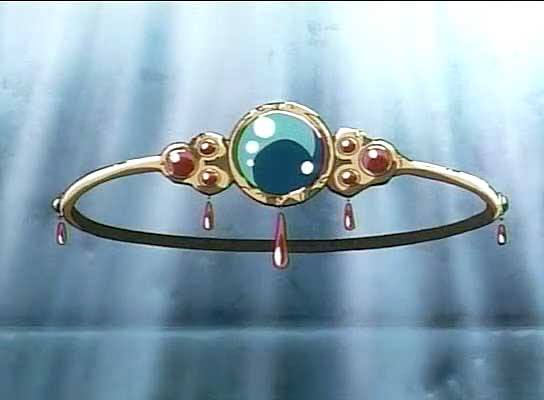 Circlet of the Pillar (See Emeraude wearing it above)
Circlet of the Pillar (See Emeraude wearing it above)
While searching for clues to who might be the new Pillar, Hikaru and Lantis set out together while the others hold down the fort, and they fall in love. Then, Hikaru is captured by one of the factions, led by the character Eagle.
While escaping, she is rejoined by her comrades, but the meeting is short. The pink haired girl, revealed to be called Nova, appears in her own black Ma-Shin, and after handily defeating all three and focusing all her seemingly psychopathic hatred on Hikaru in particular, she shatters Hikaru’s sword. This was the sword that Hikaru earned in season 1, that represents the source of her magic, all her abilities, all her access to her Ma-Shin — so this effectively makes her completely helpless and worthless to the quest, and altogether too free to wallow in despair at her share in having caused all this chaos, and her inability to help her embattled friends.
The character Presea from season 1, that forged their weapons initially, appears to help Hikaru repair her sword, but it entails a spiritual journey inside Hikaru’s psyche, to repair the source of her courage and resolve. Meanwhile, the other characters all end up in individual trials with the various invading factions. Though rather than being much of a test for the battle-hardened and already brave and capable protagonists, the trials are more of a metamorphosis for the antagonists, who all grow to respect and later even follow the heroes, much further down the line. Hikaru’s trial is all internal, and Nova appears and uses Hikaru’s despair at having killed Emeraude, and her unsure and unconfessed love for Lantis, to mentally torture her and try to prevent her from finding her courage.Hikaru eventually overcomes her inner trial, though is quite emotionally beaten by Nova, and Presea dies in the process of reclaiming the sword. Eagle invades with his army and manages to break through and enter the castle, and heads to the room of the Pillar, to steal the power of Cephiro for himself, though it turns out he wants it to save his own people back in his kingdom, from their own martial strife, not for his own selfish purposes. The castle is also being attacked by monsters, who are taking advantage of the invasion to make an even bigger distraction. As the residents flee in terror, the monsters get stronger, which is a key element of the magic of Cephiro: that one’s will brings about reality, including fear. However, some of the children stand up and comfort each other and face the monsters bravely, and that action weakens the monsters enough for the others to repel them, which is significant later. At this point, we finally meet the dark woman that we saw at Tokyo Tower, someone named Debonair, who is the queen of all the monsters, and who is behind the distractions; she goes to the room of the Pillar and tries to take the circlet for herself, but is repulsed by a last act of Emeraude’s will and love still extant in the circlet. Eagle is captured.
Hikaru has a dream and enters the mind of Emeraude, watching one of her early memories. She learns about her first falling in love with Zagato and despairing that she’s not allowed to love, because she has to selflessly pray for Cephiro, and must never put anything or anyone else first. In the dream memory, Zagato and Lantis discuss if it might be possible to destroy the Pillar forever, so that no one has to be essentially an immortal slave for the good of the world, which had turned out to be prescient for Emeraude and Zagato.Eagle breaks free from his prison in the castle and runs to the Pillar room with the circlet, Hikaru follows him. We are reminded that anyone entering the room that isn’t meant to be Pillar will be instantly destroyed. However, both of them return alive and unconscious, but not as Pillar, and no one knows what that means, other than one of them must be meant to be Pillar — perhaps the circlet just hasn’t chosen yet. However, Hikaru is torn by the possibility of becoming Pillar, which would mean she’d never be able to return to Earth.After several more attacks from the monsters, and more somewhat inverted trials with the increasingly less-antagonist more-protagonist invaders, we learn about the significance of the 2 “silent” actions at the very end of season 1. Nova is a construction of Hikaru — when she screamed in terror and self-hate and denial while killing Emeraude, by the magic of Cephiro, she forced into existence a mirror image of herself — Nova — and placed (selfishly but unconsciously) all her denial and self-hate into Nova so that she didn’t have to feel it all herself. Furthermore, the outcry of the people of Cephiro at the death of Emeraude created Debonair, who is literally the embodiment of fear and despair of the entire population of Cephiro, which is why she’s so powerful. Debonair found Nova back then, raised her as her child, and corrupted and magnified her self-hate, her Hikaru-hate.At this point, the invaders all change sides one by one and join the Magic Knights. They’ve been convinced by their righteous actions and their own trials with the Magic Knights that they should join forces to fight the monsters and save Cephiro, which is more important than conquest. Hikaru in her Ma-Shin has a final battle with Nova in hers, but Debonair betrays and abandons Nova at the last minute, and Nova’s Ma-Shin is destroyed. Hikaru unmounts hers and confronts Nova personally, one-on-one. Having thought deeply about her responsibility for feeling her own pain, she is no longer afraid of her mirror self. Nova attacks with all her might, but Hikaru merely shrugs it off; nothing Nova does can affect her any more. Nova runs away, utterly terrified, and finally curls up in a ball, screaming like a child, in fear, uncertainty, and loneliness, even crying for her “mother” Debonair, that abandoned her.In an act of kindness, forgiveness, and understanding, Hikaru caresses a terrified and defeated Nova and tells her that Debonair was really not at fault for her pain, but that she, Hikaru, was. She forced her into existence to escape her own pain and loneliness, she dumped it all into Nova. She apologizes and comforts Nova, asking her if she’d like to never be lonely, or have to shoulder all that fear all by herself, again. They embrace and merge, becoming a whole person: hope, inner pain, and all.
 Nova being comforted by Hikaru
Nova being comforted by Hikaru
With the world nearly destroyed, they finally find Debonair’s hiding place — the literal mirror-underside of Cephiro. They confront her but cannot make any headway, as they are fighting against the literal incarnation of the fear of an entire population facing destruction and no hope. However, back in the castle, the children once again remember how they weakened the monsters before, and manage to get the huddled masses to stand up and chant and sing in hope. This weakens Debonair just enough to be temporarily repulsed.At this point, the circlet finally makes a decision, and appears in front of Hikaru, the one it chooses to be Pillar, in the form of a blazing sword instead of a circlet, and offers her one wish before she becomes Pillar. First, Hikaru uses it for the three to finish off Debonair once and for all, and then makes her one wish to the Pillar: to destroy the Pillar forever. With that, the entire Pillar system is destroyed, and Cephiro is restored and becomes a place where the people can be empowered individually to make the world what they wish, rather than requiring and enslaving an imperfect immortal Pillar to pray for them.
Monomyth Contrast
The Call to Adventure
It’s a little difficult to start any story without a beginning that draws the characters into the main plot arc, so S2E1 “A Departure and New Ties” does match up with the initial steps of the Monomyth in that way. However, being season 2, the characters are not drawn into anything new, and they are brought into it (1) of their own volition, but (2) the fact that it is their volition that brings them there is not known until very late in the series. That is, Hikaru brought them there, because she would eventually be Pillar, as traveling to Cephiro can only be done by a Pillar, though they don’t know that yet. Thus, it is a rare form of entry into a required element of the plot arc.
Refusal of the Call
Unlike in the first season, where Hikaru, Umi, and Fuu argue several times over wanting to go back and give up, there is no refusal of the Call. The characters all desperately want to fix the mess they left at the end of the first season, and even when confronted with the enormity of it, they step up bravely. Though I should point out that, at least this time, they don’t really have a way back (that they know), so the refusal is not even an option.At several points in the series, the 3 friends consider the possibility of returning, and they are occasionally teased with the opportunity, but they never despair, having already tread this ground in season 1. In fact, if we skip ahead to near the end, Hikaru accepts the possibility of never being able to return to Earth, if she is in fact chosen to be Pillar, after all. Even then, they march on.
Supernatural Aid
Without having left even the first episode, we move past plot arc 3. It’s true that the 3 friends do accept their powers back immediately upon returning to Cephiro, but it isn’t an act of being given aid, it’s merely being given back what they earned long ago. At no point in season 2 do they get more aid. No more robots, no more armor, no more weapons, only a few new spells that they have to earn for themselves. In fact, they lose weapons and abilities – or at least Hikaru does for the middle third of the season. And they are perpetually teased with the aid of the circlet of the Pillar, but don’t get it until the end.
Crossing the Threshold
In the Crossing the Threshold plot point, the characters are generally confronted with the risks and dangers in the greater world around them, and often shun them, or demure from the challenge at first, and are often stopped by the darkness of the unknown surrounding familiar territory. Yet, in S2E2-6, the characters race out, immediately confronting enemies that are coming in from all sides, quite to the dismay and even horror of their allies at home, who worry for their safety but require their assistance. The darkness does not enclose them; they instead push back the veil, increasing the light of their known familiar grounds at remarkable speed.They do meet the usual “threshold guardians” that come with this point in the plot arc. However, unlike most other storylines, they are not held back by them. They actually defeat the guardians (at least temporarily), and push back the darkness, as it were. If anything, the protagonists are themselves the threshold guardians of the new set of antagonists, driving them back to their familiar ground. It is an unusual protagonist-antagonist inversion that we’ll see more of as we go on.
Belly of the Whale
Here is one place where the plot arc possibly does match up, at least half way. When Hikaru is captured by Eagle, she is forced to come to terms with being in a weakened state, and being in the belly of a giant enemy battleship — a whale metaphor, if there ever was one. However, unlike the usual Belly of the Whale story points, the hero Hikaru does not undergo a metamorphosis and emerge empowered or different. In fact, she stays firm in the face of possible change, and even has an effect on the “enemy”, instead, something we will see in the next section.One could also consider the later plot point of Hikaru’s inner trial to recover her sword to be a metamorphic journey into the Belly of the Whale. Though she isn’t really transformed for the better for it. She’s emotionally beaten and weaker in the end, at best what she was before she began, with but temporarily renewed strength.One might also consider nearly the entire season to be a Belly of the Whale for Hikaru, too. The entire process of killing Emeraude, through not conquering but embracing her fears in the form of Nova, to rejecting immortality and godhood for the sake of the people of the world. However, that’s not a plot arc point, that’s literally the entire season. The same could be said of Eagle, in that the whole season is a metamorphic event, from which he emerges changed forever; though, he also dies during the last battle, so that’s not part of a Belly of the Whale plot point.
The Road of Trials
Normally, in the Road of Trials, the heroes undergo a series of trials that test them and make them stronger. This was certainly true for season 1, in a very stereotypical fashion. But, while there is a much later test for Hikaru in S2E17, as she recovers her sword, it’s quite out of order, and it’s more or less just a rejuvenation of an earlier test already taken and passed. In fact, all three heroes confront some personal issues while rescuing Hikaru in her sword dream, but none of them are really stronger for it – they gain no new powers, they merely are exhausted and clinging to life by the end.What I find most interesting is that the trials are reversed. While each of the heroes does directly engage in an individual trial against one of the threshold guardians from earlier, they do so already having proven themselves and already come out of it stronger, in the previous season. Instead, what ends up occurring is that the enemies are undergoing the trials. They fail, but they fail in such a way that they all grow and become better for it. So much so that their respect for the heroes grows, and they end up becoming allies in the end. Thus, the transformation is mirrored upon the antagonists, perhaps “anti-antagonists”?This is especially true of the fourth and primary anti-antagonist, Eagle. He is not an enemy, but his actions drive the protagonists along. However, he is also a protagonist at the same time, and the entire plot arc is an act of his metamorphosis from antagonist to protagonist in the end.
The Meeting with the Goddess
When we reach the Meeting with the Goddess plot point, we are normally introduced to a powerful entity that is to guide the protagonists along and give them advice and some form of boon, perhaps a path to the Ultimate Boon later. Several characters might fit as the Goddess in this story, but all of them break the pattern in a different way: Emeraude, Presea, Nova, and Debonair.Princess Emeraude is already gone, from the end of Season 1, though her presence is still apparent within the circlet of the Pillar. However, she can offer no boon except the very circlet itself, and by offering it, she ceases to exist, and can’t even really hand it over or give them a path to claiming it, which is hardly Goddesslike or an achievable path to a goal.Presea could be a Goddess character, as she does provide the only path to getting back Hikaru’s broken sword. However, she’s quite mortal, and the item she offers is not the Ultimate Boon at all. It is merely a reclamation of something already earned previously and temporarily lost. If anything, her dying is the opposite of finding a powerful source of goodness and advice. Her death depresses and confuses the Magic Knights – it’s an inversion of the trope. Nova and Debonair are both still presented at this point as singularly evil antagonists. They do offer nearly Godlike presence that affects the protagonists and the plot, and they do, ironically, represent a path to the Ultimate Boon, in their own way, but they are not the powerful forces of good there to lead the way. Again an anti-trope.
Woman as Temptress
There is also no Woman as Temptress in this plot. There are very fleeting offers to return the protagonists to Earth, which are soundly rejected. However, there is a very interesting reverse temptation going on across the storyline, that inverts the trope curiously. When we eventually find out about Nova being the mirror image of Hikaru’s emotions, and how Hikaru needs to come to terms with the negative half of herself in order to be whole, we do have a temptation (by a woman – Hikaru herself) to fall into despair, and to take the world on one’s shoulders to the point of self-destruction, possibly failing the quest in the process. This inner-temptation is not to give up on the path, but to fall victim to one’s own frailties while doing so. An inner jihad, perhaps.
Atonement with the Father
There is also no Father figure in the story. Clef is the Gandalf-Dumbledore type character that always helps them out, there is no atonement with him. Learning more about Zagato in season 2 forces the story to flirt with the idea of his character being a father figure, but he’s already dead and gone in the present, and cannot be confronted. Princess Emeraude was already confronted at the end of the previous season, literally, in order to achieve atonement. But in that case, it was the power figure (Emeraude) doing the atoning. And, in any case, it was in the previous story, not season 2.If there is an antagonist figure that requires standing up to, it’s Nova, once again, from the above Temptress trope. Near the end of the story, Hikaru needs to come to terms with her own negative emotions and take responsibility for them, and face the pain and suffering inside. In this way, the Father figure she needs to confront is actually herself, not an external antagonistic entity, no matter how external Nova seems to be, up until that point. If there’s an atonement with a father on Hikaru’s part, it’s an act of self-parenting.
Apotheosis
The three significant deaths in the season are Presea, Nova (to the degree one could consider it a death), and Eagle. However, both of these present a problem mapping them onto the Hero’s Journey arc. The Apotheosis is generally the time of reckoning and respite before the Return (below) third of the arc, or at least before the claiming of the Ultimate Boon. Presea’s death is perhaps the closest to the trope of the three. However, first, it comes far too early for this, and, as we’ll see below, the Return arc is itself reversed or broken in several ways. Second, there’s no time for respite and escape to a safe place associated with this point in the plotline, as there would be with an Apotheosis. Finally, it does not spark a return to the thrust of the quest, nor does it provide access to the Ultimate Boon. If we stretch the trope to mean any boon, in this case, returning Hikaru’s sword, it fits slightly, in that there is a slight lull in the action for a bit, after which the plot continues. One could consider Nova’s assimilation back into Hikaru as an Apotheosis, but it is very late in the plotline, after several intervening plot points have already started and finished. And there is no bestowment of an Ultimate Boon, nor is there a Return that comes from it. One could also argue that Nova’s assimilation is not actually a death, but a blessing of new life. However, in another way, it is a consolidation of opposing forces and thus creation of enlightenment.The death of Eagle might be an abstract apotheosis, as his death as one of two possible Pillars does lead to the party getting the Ultimate Boon… but it’s not a period of respite and reckoning before a “return” arc, it’s basically the penultimate event in the series just before the final confrontation. Thus, it’s very out of order and missing elements present in the usual myth.
The Ultimate Boon
The Ultimate Boon is an enormous tease in MKR2. While Hikaru regaining use of her sword is one boon that’s claimed mid-season, it is certainly not the Ultimate one. Also, Lantis gives Hikaru a pendant at one point, that saves her from death once, but that’s also not an Ultimate Boon. The Ultimate one is the circlet of the Pillar itself, and it’s known from very early on. However, it’s a ruse. The characters can’t have it. It will literally destroy them if they try to take it. And it is never given to any character at any point until the last 5 minutes of the entire story. It’s yet another anti-trope.There is no Subtle Knife or One Ring that accompanies the characters as they fight the darkness, nothing to tempt them, nothing to empower them.
Refusal of the Return
There are two potential “refusal of returns” in MKR2, but none of them follow the Monomyth arc, where the heroes find peace someplace and don’t want to return to complete their quest.First, there is a constant temptation for the 3 friends to return to Earth, but the temptations are fleeting, and there is no return and then a refusal to come back. There is a short timeframe where they are tricked into thinking that they have returned to Earth, and have to decide whether to do so. But it is also fleeting, they are always driven to move forwards, not to stay anywhere safe to avoid saving Cephiro from collapse.Second, there is a sense in which the “return” could mean a return to the struggle to save the world — the sense that Hikaru despairs making similar mistakes from the first time (in having to kill Emeraude), and cannot drive herself to continue. However, this is not an escape to a placid place where the heroes are tempted to stay and not continue the quest. In fact, it’s an inner Hell for Hikaru, where she’s emotionally imprisoned and paralyzed. Instead, it is more of a trial to overcome, and they do so internally, without Rescue from Without, and without a Magical Flight, both below.
The Magic Flight
Simply put, there is no Magical Flight from the powers that be, escaping at the last moment with the Ultimate Boon, or anything else. There is a final rush to fight Debonair before the world collapses, having only found her location at the last moment, and knowingly without having the power of the Pillar behind them (yet)… but no chase scene with any required magical plot gubbin, or a bare escape from the proverbial crumbling prison.
Rescue from Without
While every long story has moments where allies come to the rescue, that’s not what this mythical point is about. We are still in the “return” phase, where the heroes need to be coaxed back into completing the quest. In the Hero’s Journey, someone or something needs to “rescue” the hero from their safe space and convince them to get back in gear and finish their quest.But that doesn’t exist here, the only one that finds it hard to continue the quest is Hikaru, at her darkest of despair, before re-merging with Nova and coming to terms with her inner pain. Her friends Umi and Fuu do comfort her, but her rescue is of the inner kind, and had to be accomplished herself. And it’s not much of a “from without”, as the three are all the main heroes of the story.Though I would like to point out that the concept of an external rescue is routinely turned on it’s head. Not only do characters often end up rescuing themselves before help arrives, but their competition sometimes ends up rescuing them, out of respect or love. And in the final moments of the fight with Debonair, it’s the frightened children that do the rescuing, but only after rescuing themselves from their own fear first.
The Crossing of the Return Threshold
Once again, there’s not much of a return for there to be a threshold of. However, in the sense that Hikaru overcomes her inner world and returns, once again whole, to the fight, might suffice in an abstract way. Thus, either her resolve to confront Nova, or her resolve to finish off Debonair shortly afterwards, might be a crossing point.
Master of Two Worlds
The final two journey points most definitely do exist in MKR2. In fact, they’re present to an extreme degree. In this step, the hero(es) succeeds in finding balance between opposing forces, the inner and outer, the material and spiritual. Though this might be because a specific theme of MKR2 is reflection and inversion, which results in a lot of “two worlds” to master.
- Cephiro and Earth are two worlds that find balance.
- Cephiro and under-Cephiro where Debonair lives find balance
- Hikaru literally merges two halves of herself into a whole
- The Pillar chooses between two heroes to save the world, so perhaps this should be a Two Masters of One World anti-trope
- Consolidating power into a Pillar and spreading it out into the population is a balance of forces
- Finding the balance between responsibility to others, and the ability to love for one’s own emotional well-being, balance by destroying the Pillar system
- The people save the Magic Knights, and the Magic Knights save the people, reciprocally — one a physical saving, one a spiritual one
Freedom to Live
The final trope, freedom from fear and death, living in the present, is the literal meaning of the end of the series. The people free themselves from fear in order to empower the Magic Knights, and the Magic Knights free the Pillar from enslavement to the people. They also free themselves, because there will never again be a Pillar that needs to call upon the Magic Knights to self-terminate. The people of Cephiro and the surrounding countries are also free to live in peace in a new alliance.
Conclusion
Other than the very first and last trope, which are somewhat necessary for any story, whether it’s following a Hero’s Journey or not, the plot arc of Magic Knights Rayearth Season 2 overlaps very little with the Monomyth. The Master of Two Worlds trope is extremely strong in it, though perhaps because there is so much mirror imagery in the story, so that patterns of two naturally appear all over. However, outside of that coincidence, the story regularly rebukes the common archetype (or maybe I should say arc-type), to create an entirely differently shaped plotline. Rather than a slow gathering of power within a hero or heroes, with occasional setbacks, a penultimate nadir, and a final battle… we have basically a continuous slide into catastrophe. Everything gets worse, everyone gets weaker, the antagonists do the soul-searching, the extras save the heroes… in the end, the enemy, the goddess, the temptress, and the father figure are all staring back at the hero in the mirror. The storyline is a dark and inverted reflection of a Hero’s Journey, that is itself filled with themes of reflections.
 The musical intro to each episode starts with the foreshadowing of Nova and Hikaru literally reflecting each other
The musical intro to each episode starts with the foreshadowing of Nova and Hikaru literally reflecting each other
